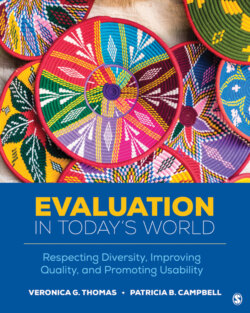Читать книгу Evaluation in Today’s World - Veronica G. Thomas - Страница 171
На сайте Литреса книга снята с продажи.
Summary
ОглавлениеClearly, evaluation in some form has evolved over the entire history of people’s existence, although systematic program evaluation began to come into its own in the early to mid-20th century. Program evaluation is very much rooted in the sociopolitical and legislative climate of its time. Although there were many explicit racialized experiences (e.g., racism, Jim Crow laws) for persons of color, particularly African Americans, during evaluation’s early history, such events were not adequately reflected in the social programming or evaluations of that time. Further, there has been little discussion of the evolution of evaluation through a social justice lens when recounting its history.
Over the years, the federal government has played an enormous role in the historical evolution of evaluation. Datta (2003) identifies eight influences of the government on the evaluation profession and of evaluation on the government, including increasing the
demand for internal evaluation within the federal government;
demand for internal evaluation among the recipients of federal support;
demand for external evaluation among the recipients of federal support;
specification of methods, designs, and measures to be used;
support for the development of evaluation as a profession;
creation of opportunities for employment of evaluators;
leadership for evaluation emulated by nongovernmental entities such as private foundations; and
support of evaluation capacity such as evaluation training, development of standards and definition of evaluation, and a professional infrastructure.
Foundations have also made substantial contributions to evaluation over the years through funding demonstration projects and evaluation efforts.
There is much to trace in the evolution of evaluation, and it is impossible to neatly fit it into a single chapter. Our attempt was to trace the historical evolution of evaluation to the present time through a more inclusive and social justice lens. We covered notable, and sometimes ignored, events and people contributing to this evolution. Other noteworthy events and influencers not mentioned in this chapter are found elsewhere throughout this text. Currently, there are numerous professional evaluators, with diverse perspectives, around the world conducting evaluations in a variety of areas such as health, education, and criminal justice. These evaluators are employed in a myriad of settings including universities, research institutes, government agencies, K–12 school districts, and private industry. Knowledge of the evolution of program evaluation, its various traditions, and key figures/events within a sociocultural context can better help these and aspiring evaluators appreciate current evaluation perspectives, recurring issues, and persistent gaps.
The evaluation of programs designed to ameliorate social problems is not going away. And, undoubtedly, program evaluation will continue to evolve in a changing and increasingly diverse society. The challenge to the profession as it evolves into the future is to continue its push to make evaluations more socially just, inclusive, methodologically sound, and useful to intended users.
